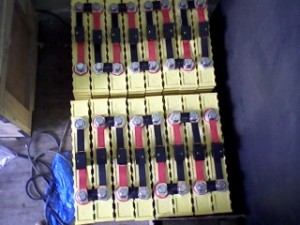Flooding (again!)
Its 2.30am as I write this. I’m up on ‘log watch’ because the river is in flood, fairly minor so far, but enough to bring down some logs and other flotsam. Every now and then one gets stuck on the bow, and I need to don my wet weather gear and dislodge it. And every couple of minutes there’s bump-donk-donk-donk-donk as its rattles its way along the hull. And less often but more disturbing is the bump-eeeeeeeeeeeeek kind of log that scratches its way along the boat.
Crikey! She’s only just got back in the water from fitting a new bowsprit after damage in the last flood. (See Broken Mooring entry). Right now she’s moored to a jetty – in the last flood all the boats on jetties fared better than those on moorings. I contemplated moving downstream on anchor, but there’s a gale warning for tomorrow, and it would be a more exposed position. So I decided to stay on the jetty which is well shielded from the E/NE winds.
While I’m up I might as well check the weather, and here’s what’s happening upstream in this river right now.
And is if that not enough to catch my attention, I checked out the flood warnings… uh oh. back to log watch.
FLOOD WARNING FOR COASTAL STREAMS BETWEEN NOOSA AND COOLANGATTA
Issued at 11:50 PM on Tuesday the 19th of May 2009
by the Bureau of Meteorology, Brisbane.
Periods of heavy rain are causing stream rises and some flooding in coastal streams between Noosa and the Queensland-New South Wales border, extending inland to the ranges. Minor flood levels have been reached in smaller Sunshine Coast streams, in the upper Stanley River around Peachester and Burpengary Creek. A Severe Weather Warning is current for the area. During the next 24 to 48 hours, further creek and river rises causing flooding are likely throughout south east Queensland from Noosa to the Queensland-New South Wales border and extending inland to the ranges.
Battery discharge test
Some of you who follow this blog are interested in the technicalities of setting up an electric boat. This post is for you – it has details about testing the Lithium-Ion batteries to be sure how much capacity they have.
First some background – some pecularities of these LFP batteries mean they require different management than regular lead-acid batteries. As this is my primary energy source for the motor, and you could consider it as a fuel tank, I need to know how much fuel is in the tank. I need to know how full is the tank, and how much fuel does it hold.
These batteries are 200 Ah capacity and I want to run a test to prove that they do in fact have this much capacity. That is, how much fuel does the tank hold. I had run into a problem earlier, when a low voltage alarm warned me that the batteries are flat – that is, the tank is empty – after I’d used only 30 amphours. But at that time I couldn’t be sure that the tank was full to begin with – or even close.
So for this test, the first step was to make sure the tank is full. You would think this is pretty simple, but this highlights another pecularity of LFP cells. Individual cells can have different charge/discharge rates – I’m not entirely sure why, but I expect its due to differing internal resistence.
Each cell has its own regulator – and here I’ll call them cell modules – and this cell module will protect the cell from over charging. When the cell reaches 3.84 volts, the cell module begins to bypass power – its just burns it off. When that happens a red LED light comes on. Here’s a photo of the cells in the workshop after fitting of the cell modules and wiring them together.
Anyway, to be sure that the tank is full, I need to see red on every cell. So I charged the pack and gradually the cell modules began to light up red. It got to 13 of the 16 cells were red, and the other three remained stubbornly green. The cells are in a difficult location under the cockpit and its not easy to reach to each cell with the probes of a multimeter to measure the voltage. So I ran wires to each cell and then back to a common point so I could easily measure the voltage of individual cells, and I could individually charge each cell. Running these wires was quite a project – it took many days and I still have four to do.
I could now charge the individual cells and was able to do so on the three reluctant cells until each showed red. So I had all the cells to red and was ready for a discharge test by early this week.
Luckily I scored a jetty on Monday – and being tied to a jetty is a good place to run the test. So I ran the motor at 5 to 20 amps depending on the tidal flow at the time. And I monitored the Link 10 battery monitor. It shows cumulative amphours drained from the batteries. I wanted to drain them to 80% discharge (160 amphours) to begin with, and then go lower while closely monitoring the voltage of individual cells.
Over two days I used up power and at 144 amphours the low voltage alarm went off. Bugger!
This is worrying. I should easily have this much power. This highlights another pecularity of these cells. The voltage hardly drops at all for most of the disharge. It gradually creeps down – and then it falls off very suddenly to low voltage. So its difficult to monitor the available powet by watching voltage alone.
I checked the voltage of individual cells. All the cells that were attached to the common board – the easy ones to measure – were reading 3.2 volts – which means they are ok. I had to crawl down under the cockpit to measure the other four – and I could see that on one of them, the light was off, meaning low voltage. I measured it at 2.64 volts. The alarm went off at 2.5 volts, and then after turning the motor off the voltage recovered to 2.64 in the 5 minutes it took me to measure the voltages.
What now? I’m consulting the supplier for advice. Perhaps because the batteries are new there’s some cycling or such that they need to ensure full capacity. I hope so. In the next few days I’ll be busy with other things and in that time the sun will begin to charge the batteries back up again.
But it looks now that the tank holds not even three quarters of its rated capacity – and that due to just one cell being low.

















